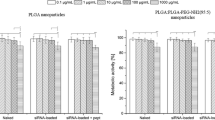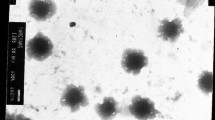Abstract
Low molecular weight substrates of the efflux transporter, P-glycoprotein, alter the biodistribution and tissue retention of nanoparticles following intravenous administration. Of particular interest is the retention of the targeted nanoparticles in the brain. Drug delivery to the brain is hindered by the restricted transport of drugs through the blood-brain barrier (BBB). Drugs that passively diffuse across the BBB also have large volumes of distribution; therefore, alteration of their biodistribution to increase their concentration in the brain may help to enhance efficacy and reduce off-target side effects. In this work, targeted nanoparticles were used to explore a new approach to target drugs to the brain—the exploitation of the P-glycoprotein efflux pump. The retention of nanoparticles containing a strong P-glycoprotein substrate, rhodamine 6G, tethered to a PLA nanoparticle through a PEG spacer was greater than twofold relative to untargeted nanoparticles and to nanoparticles tethered to a weaker P-glycoprotein substrate, rhodamine 123. In a P-glycoprotein knockout mouse model (mdr1a (-/-)), there were no significant differences in brain accumulation between rhodamine 6G-targeted particles and controls, strongly supporting the role of P-glycoprotein. This proof of concept report shows the potential applicability of low molecular weight P-gp substrates to alter nanoparticle biodistribution.
Lay Summary
The efficacy of medicines can be improved by diverting drugs to specific tissues. Finding new ways to target medicines to diseased tissue is an active area of research across disciplines. Drug-loaded nanoparticles, delivered to tissues of interest, are one way to accomplish this goal. The work reported in this manuscript explores the possibility of using small molecules to get nanoparticles to bind to a drug efflux pump, P-glycoprotein (P-gp), that is present in various tissues in the body. P-gp functions to remove drugs from tissues, and it is usually considered a hindrance to drug targeting. The research in this paper shows that the natural function of P-gp can be used favorably to retain nanoparticles in various tissues.
Future Work
The data reported in this manuscript serves to establish a proof-of-concept that low molecular weight P-gp substrates can be used to alter the biodistribution of nanoparticles. Future work includes (1) understanding the targeting mechanism(s) that lead to these results, (2) identifying FDA-approved drugs that can target nanoparticles, and (3) evaluating how nanoparticle biodistribution is altered by using P-gp substrates with different binding constants.






Similar content being viewed by others
References
Pangalos MN, Schechter LE, Hurko O. Drug development for CNS disorders: strategies for balancing risk and reducing attrition. Nat Rev Drug Discov. 2007;6:521–32.
Pardridge WM. Blood-brain barrier delivery. Drug Discov Today. 2007;12:54–61.
Aryal M, Arvanitis CD, Alexander PM, McDannold N. Ultrasound-mediated blood-brain barrier disruption for targeted drug delivery in the central nervous system. Adv Drug Deliv Rev. 2014;72:94–109.
Lochhead JJ, Thorne RG. Intranasal delivery of biologics to the central nervous system. Adv Drug Deliv Rev. 2012;64:614–28.
Crawford L, Rosch J, Putnam D. Concepts, technologies, and practices for drug delivery past the blood-brain barrier to the central nervous system. J Control Release. 2016;240:251–66.
Pardridge WM. Blood-brain barrier drug targeting: the future of brain drug development. Mol Interv. 2003;3:90–105.
Lu CT, Zhao YZ, Wong HL, Cai J, Peng L, Tian XQ. Current approaches to enhance CNS delivery of drugs across the brain barriers. Int J Nanomedicine. 2014;9:2241–57.
Ulbrich K, Hekmatara T, Herbert E, Kreuter J. Transferrin- and transferrin-receptor-antibody-modified nanoparticles enable drug delivery across the blood-brain barrier (BBB). Eur J Pharm Biopharm. 2009;71:251–6.
Qian ZM, Li H, Sun H, Ho K. Targeted drug delivery via the transferrin receptor-mediated endocytosis pathway. Pharmacol Rev. 2002;54:561–87.
Salvati A, Andrzej S, Pitek AP, Monopoli MP, Prapainop K, Bombelli FB, et al. Transferrin-functionalized nanoparticles lose their targeting capabilities when a biomolecule corona adsorbs on the surface. Nat Nanotechnol. 2013;8:137–43.
Gupta Y, Jain A, Jain SK. Transferrin-conjugated solid lipid nanoparticles for enhanced delivery of quinine dihydrochloride to the brain. J Pharm Pharmacol. 2007;59:935–40.
Ulbrich K, Knobloch T, Kreuter J. Targeting the insulin receptor: nanoparticles for drug delivery across the blood-brain barrier (BBB). J Drug Target. 2011;19:125–32.
Loureiro J, Gomes B, Coelho MN, do Carmo Pereira M, Rocha S. Targeting nanoparticles across the blood-brain barrier with monoclonal antibodies. Nanomedicine. 2014;9:709–22.
Couch JA, Yu YJ, Zhang Y, Tarrant JM, Fuji RN, Meilandt WJ, et al. Addressing safety liabilities of TfR bispecific antibodies that cross the blood-brain barrier. Sci Transl Med. 2013;5:183ra57, 1–12.
Pardridge WM. Blood–brain barrier drug delivery of IgG fusion proteins with a transferrin receptor monoclonal antibody. Expert Opin Drug Deliv. 2015;12:207–22.
Gao X, Qian J, Zheng S, Changyi Y, Zhang J, Ju S, et al. Overcoming the blood–brain barrier for delivering drugs into the brain by using adenosine receptor nanoagonist. ACS Nano. 2014;8:3678–89.
Lin T, Zhao P, Jiang Y, Tang Y, Jin H, Pan Z, et al. Blood–brain-barrier-penetrating albumin nanoparticles for biomimetic drug delivery via albumin-binding protein pathways for antiglioma therapy. ACS Nano. 2016;10:9999–10012.
Cascorbi I. P-glycoprotein: tissue distribution, substrates, and functional consequences of genetic variations. Handb Exp Pharmacol. 2011;201:261–83.
Iwahashi T, Okochi E, Ariyoshi K, Watabe H, Amann E, Mori S, et al. Specific targeting and killing activities of anti-P-glycoprotein monoclonal antibody MRK16 directed against intrinsically multidrug-resistant human colorectal carcinoma cell lines in the nude mouse model. Cancer Res. 1993;53:5475–82.
Crawford L, Putnam D. Synthesis and characterization of macromolecular rhodamine tethers and their interactions with P-glycoprotein. Bioconjug Chem. 2014;25:1462–9.
Ornatsky O, Baranov V, Shen L, Abdelrahman A, Winnik MA. Lanthanide-containing polymer nanoparticles for biological tagging applications: nonspecific endocytosis and cell adhesion. J Am Chem Soc. 2007;129:13653–60.
Crawford L, Higgins J, Putnam D. A simple and sensitive method to quantify biodegradable nanoparticle biodistribution using europium chelates. Sci Rep. 2015;5:13177.
Friedman AD, Claypool SE, Liu R. The smart targeting of nanoparticles. Curr Pharm Des. 2013;19:6315–29.
Han H, Davis ME. Single-antibody, targeted nanoparticle delivery of camptothecin. Mol Pharm. 2013;10:2558–67.
Liang C, Guo B, Wu H, Shao N, Li D, Liu J, et al. Aptamer-functionalized lipid nanoparticles targeting osteoblasts as a novel RNA interference-based bone anabolic strategy. Nat Med. 2015;21:288–94.
Farokhzad OC, Cheng J, Teply BA, Sherifi I, Jon S, Kantoff PW, et al. Targeted nanoparticle-aptamer bioconjugates for cancer chemotherapy in vivo. Proc Natl Acad Sci U S A. 2006;103:6315–20.
Stefanick JF, Ashley JD, Bilgicer B. Enhanced cellular uptake of peptide-targeted nanoparticles through increased peptide hydrophilicity and optimized ethylene glycol peptide-linker length. ACS Nano. 2013;7:8115–27.
Low PS, Henne W, Doorneweerd DD. Discovery and development of folic-acid-based receptor targeting for imaging and therapy of cancer and inflammatory diseases. Acc Chem Res. 2008;41:120–9.
Zhao X, Li H, Lee RJ. Targeted drug delivery via folate receptors. Expert Opin Drug Deliv. 2008;5:309–19.
Popielarski SR, Pun SH, Davis ME. A nanoparticle-based model delivery system to guide the rational design of gene delivery to the liver. 1. Synthesis and characterization. Bioconjug Chem. 2005;16:1063–70.
Cruz LJ, Tacken PJ, Pots JM, Torensma R, Buschow SI, Figdor CG. Comparison of antibodies and carbohydrates to target vaccines to human dendritic cells via DC-SIGN. Biomaterials. 2012;33:4229–39.
Weissleder R, Kelly K, Sun EY, Shtatland T, Josephson L. Cell-specific targeting of nanoparticles by multivalent attachment of small molecules. Nat Biotechnol. 2005;23:1418–23.
https://www.cdc.gov/nchs/data/nvsr/nvsr64/nvsr64_02.pdf. Accessed May 14, 2019.
https://www.cancer.org/content/dam/cancer-org/research/cancer-facts-and-statistics/annual-cancer-facts-and-figures/2015/cancer-facts-and-figures-2015.pdf. Accessed May 14, 2019.
DiMasi J, Feldman L, Seckler A, Wilson A. Trends in risks associated with new drug development: success rates for investigational drugs. Clin Pharmacol Ther. 2010;87:272–7.
Abbott NJ. Blood-brain barrier structure and function and the challenges for CNS drug delivery. J Inherit Metab Dis. 2013;36:437–49.
Lajoie JM, Shusta EV. Targeting receptor-mediated transport for delivery of biologics across the blood-brain barrier. Annu Rev Pharmacol Toxicol. 2015;55:613–31.
Gan CW, Feng SS. Transferrin-conjugated nanoparticles of poly(lactide)-d-alpha-tocopheryl polyethylene glycol succinate diblock copolymer for targeted drug delivery across the blood-brain barrier. Biomaterials. 2010;31:7748–57.
Huang RQ, Qu YH, Ke WL, Zhu JH, Pei YY, Jiang C. Efficient gene delivery targeted to the brain using a transferrin-conjugated polyethyleneglycol-modified polyamidoamine dendrimer. FASEB J. 2007;21:1117–25.
Pardridge WM. Targeted delivery of protein and gene medicines through the blood-brain barrier. Clin Pharmacol Ther. 2015;97:347–61.
Aller SG, Yu J, Ward A, Weng Y, Chittaboina S, Zhuo R, et al. Structure of P-glycoprotein reveals a molecular basis for poly-specific drug binding. Science. 2009;323:1718–22.
Kubin RF, Fletcher AN. Fluorescence quantum yields of some rhodamine dyes. J Lumin. 1982;27:455–62.
Savarese M, Aliberti A, De Santo I, Battista E, Causa F, Netti PA, et al. Fluorescence lifetimes and quantum yields of rhodamine derivatives: new insights from theory and experiment. J Phys Chem A. 2012;116:7491–7.
Adamczyk M, Grote J. Synthesis of probes with broad pH range fluorescence. Bioorg Med Chem Lett. 2003;13:2327–30.
Eytan GD, Regev R, Oren G, Hurwitz CD, Assaraf Y. Efficiency of P-glycoprotein-mediated exclusion of rhodamine dyes from multidrug-resistant cells is determined by their passive transmembrane movement rate. Eur J Biochem. 1997;248:104–12.
Hild W, Pollinger K, Caporale A, Cabrele C, Keller M, Pluym N, et al. G protein-coupled receptors function as logic gates for nanoparticle binding and cell uptake. Proc Natl Acad Sci U S A. 2010;107:10667–72.
Loo TW, Bartlett MC, Clarke DM. Methanethiosulfonate derivatives of rhodamine and verapamil activate human P-glycoprotein at different sites. J Biol Chem. 2003;278:50136–41.
Acknowledgments
This work was made possible by a Graduate Fellowship to L.C. from the National Science Foundation. We particularly thank Prof. Bill Brown in the Department of Molecular Biology & Genetics at Cornell for use of his ultracentrifuge. This work made use of the Cornell Center for Materials Research Shared Facilities, which are supported through the NSF MRSEC program (DMR-1719875).
Author information
Authors and Affiliations
Corresponding author
Ethics declarations
All research involving animals was conducted under IACUC approval at Cornell University. Specific approved protocol numbers are provided in the text of the manuscript in the relevant sections.
Conflict of Interest
The authors declare no real or apparent conflicts of interest.
Ethical Approval
All applicable international, national, and/or institutional guidelines for the care and use of animals were followed. All procedures performed in studies involving animals were in accordance with the ethical standards of the institution or practice at which the studies were conducted.
Additional information
Publisher’s Note
Springer Nature remains neutral with regard to jurisdictional claims in published maps and institutional affiliations.
Electronic supplementary material
ESM 1
(DOCX 473 kb)
Rights and permissions
About this article
Cite this article
Crawford, L.A., Watkins, H.C., Wayne, E. et al. Altered Biodistribution and Tissue Retention of Nanoparticles Targeted with P-Glycoprotein Substrates. Regen. Eng. Transl. Med. 5, 308–318 (2019). https://doi.org/10.1007/s40883-019-00111-8
Received:
Revised:
Accepted:
Published:
Issue Date:
DOI: https://doi.org/10.1007/s40883-019-00111-8




